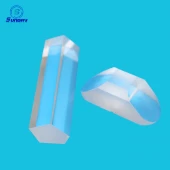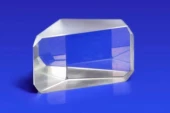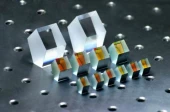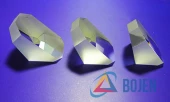Description
ARD Optics presents custom-made pentagonal prisms, meticulously crafted according to your designs. Our prisms are distinguished by their optically polished surfaces, extraordinary flatness, and precise angular accuracy. Whether it’s for research, industry, or high-tech applications, our prisms are engineered for unparalleled performance.
Product Highlights:
- Optically Polished Surfaces: Achieve surface quality up to S/D 20/10, surpassing MIL-PRF-13830B standards.
- Exceptional Surface Flatness: Up to λ/6 at 632nm, ensuring top-notch performance.
- Precision Angles: Angular accuracy of up to ±20 arc seconds.
- Stringent Dimensional Tolerances: Linear dimensions are maintained within ±0.01mm.
About ARD Optics: As a seasoned provider of custom optics, ARD Optics is dedicated to delivering intricately crafted optical components tailored to your specific needs. Our commitment to quality, innovation, and customer satisfaction has made us an industry leader.
Have a Unique Requirement? Utilize the "Inquire Price" button to get in touch with us. Our experts are at your disposal to understand your requirements and offer the best solutions.
High-Precision Pentagonal Prism by ARD Optics
Specifications
| Material: | BK7, FS, N-SF11, Other |
|---|---|
| Dimension (A): | 8 mm |
| Dimension (B): | 30 mm |
| Mounting: | Unmounted |
| Surface Quality: | S/D 20/10 |
| Surface Flatness: | λ/6 @ 632 nm |
| Angular Accuracy: | ±20 arc seconds |
| Linear Dimensions Tolerances: | ±0.01 mm |
Features
- Custom-Designed Fabrication: Tailor-made pentagonal prisms crafted according to client specifications for a perfect fit in your optical setup.
- Superior Surface Quality: Optically polished surfaces with an exceptional S/D 20/10 quality level that meets the stringent MIL-PRF-13830B standards.
- High Surface Flatness: Achieve optimal performance with surface flatness up to λ/6 at 632nm, crucial for precise optical applications.
- Precision Angles: Angular accuracy of up to ±20 arc seconds ensures that the prism will perform with the utmost precision in critical applications.
- Tight Dimensional Tolerances: With linear dimensions tolerances of just ±0.01mm, the prisms are crafted with incredible accuracy.
- Versatile Material Options: Choose from various high-quality materials including BK7, FS, N-SF11, or inquire about additional options to meet your specific needs.
- Compact and Efficient Design: With dimensions of 8mm (Side A) and 30mm (Side B), the prism’s design is both compact and efficient for versatile applications.
- Expertise and Experience: Backed by ARD Optics' experience in custom optics, ensuring high-quality products and customer satisfaction.
- Ready for Custom Mounting: The prism comes unmounted, providing flexibility for custom mounting solutions to suit various setups.
Applications
- Beam Steering: In laser systems, the prism can be used to steer a beam of light to a specific direction without changing its path length.
- Image Rotation: Pentagonal prisms can be used in optical systems to rotate images, which is useful in microscopy and imaging applications.
- Dispersion of Light: Utilizing the prism's properties to disperse light into its spectrum; useful in spectroscopy for analyzing the properties of light.
- Optical Path Length Adjustment: In interferometry, the prisms can be used to alter optical path lengths for creating interference patterns for measurement and analysis.
- Optical Instrumentation: Incorporated in devices like telescopes, microscopes, and other optical instruments to manipulate light paths and improve image quality.
- Laser Alignment: Used within laser systems to align or re-direct the laser beam with precision.
- Educational Demonstrations: Serving as an educational tool in classrooms and laboratories for demonstrating optical phenomena like refraction and dispersion.
- Research and Development: Employed in R&D labs for experimenting with light paths, beam steering, and other optical characteristics.
- Photonics and Fiber Optics: Used in photonics systems for manipulating light paths, particularly in fiber optic communication systems.
- Quality Control: In manufacturing, the prisms can be a part of inspection systems to ensure product quality through precise imaging and measurements.
Frequently Asked Questions
What materials are available for the pentagonal prism?
What are the dimensions of the prism?
Is the prism mounted or unmounted?
What is the surface quality of the prism?
What is the surface flatness of the prism?
What is the angular accuracy of the prism?
What are the tolerances for the linear dimensions?
Can I request a custom design for the pentagonal prism?
How do I get a quote for my specific requirements?
What are some applications for the pentagonal prism?
What are the surface quality standards of ARD Optics' pentagonal prisms?
What is the surface flatness of the prisms?
What is the angular accuracy of the prisms?
What are the dimensional tolerances of the prisms?
What materials are the prisms made of?
Similar Products






Your inquiry has been received.
Create an account by adding a password
Why create an account?
- Auto-complete inquiry forms
- View and manage all your past messages
- Save products to your favorites
- Close your account anytime — no hassle
